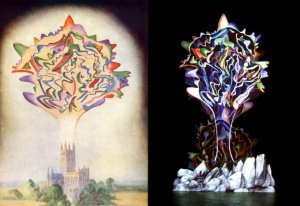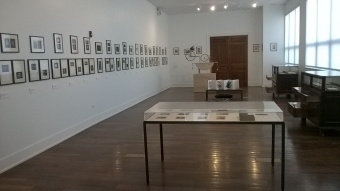Thought Forms (book): Difference between revisions
No edit summary |
No edit summary |
||
| Line 64: | Line 64: | ||
A number of drawings, paintings, installations, films, objects, books, collaborations, and research-based events will be viewable as thought forms – waves or oscillating patterns of repeating and differing lines that structure and enfold all forms of transference of energy – from brain waves to shockwaves after an explosion, from sound waves and waves of water to electromagnetic waves of different lengths and frequencies, including radio waves and light.<ref>Carolyn Christov-Bakargiev, "Saltwater: A Theory of Thought Forms." April 4, 2015. Istanbul Foundation for Culture and the Arts website. [http://bienal.iksv.org/en/archive/newsarchive/p/1/1139 IKSV Bienal].</ref> | A number of drawings, paintings, installations, films, objects, books, collaborations, and research-based events will be viewable as thought forms – waves or oscillating patterns of repeating and differing lines that structure and enfold all forms of transference of energy – from brain waves to shockwaves after an explosion, from sound waves and waves of water to electromagnetic waves of different lengths and frequencies, including radio waves and light.<ref>Carolyn Christov-Bakargiev, "Saltwater: A Theory of Thought Forms." April 4, 2015. Istanbul Foundation for Culture and the Arts website. [http://bienal.iksv.org/en/archive/newsarchive/p/1/1139 IKSV Bienal].</ref> | ||
</blockquote> | </blockquote> | ||
[[File:Intention to Know exhibit.jpg|right|340px|thumb|"Intention to Know" exhibit, February 27, 2016.]] | |||
Subsequently, a portion of the Turkish exhibit was displayed as '''Intention to Know: The Thought Forms of Annie Besant''', an exhibit presented from December 29, 2015 through March 1, 2016 at the Stony Island Arts Bank in Chicago following the run in Turkey. The display was conceived by Carolyn Christov-Bakargiev in cooperation with Theaster Gates and the Rebuild Foundation. | Subsequently, a portion of the Turkish exhibit was displayed as '''Intention to Know: The Thought Forms of Annie Besant''', an exhibit presented from December 29, 2015 through March 1, 2016 at the Stony Island Arts Bank in Chicago following the run in Turkey. The display was conceived by Carolyn Christov-Bakargiev in cooperation with Theaster Gates and the Rebuild Foundation. | ||
<blockquote> | <blockquote> | ||
Revision as of 15:23, 3 March 2016
Thought Forms was a book written by Annie Besant and Charles Webster Leadbeater in 1905 on the titular subject of Thought-Forms.
Writing of the book
The genesis of the book was an article by Annie Besant printed in the September, 1896 issue of Lucifer.[1] These are the original illustrations from that article:
Charles Leadbeater worked with Annie Besant to develop this concept further, describing their clairvoyant observations to painters to produce the images for the 1905 book. The illustrations were painted by "Mr. John Varley [1850-99, grandson of John Varley], Mr. Prince and Miss Macfarlane."
Publication history
The first edition of Thought-Forms came out in 1905. It was published in London and Benares by the Theosophical Publishing Society, and in New York by John Lane. In the United States, the book was distributed by the Theosophical Book Concern of Chicago. The volume was hardbound in both green and red covers.
When the next edition was published in 1925 by the Theosophical Publishing House, it incorrectly stated "First Printed 1901 - Reprint 1905 - Reprint 1925." John L. Crow wrote an account of how this error was propagated through subsequent editions and library catalogs. "Why the date of 1901 was introduced is unknown. Kurt Leland, an Annie Besant specialist, theorized that the publishers were confused by Besant's publication, Thought Power, which was published in 1901."[2]
In 1933, 1948, 1961, and 1967, the book was reprinted by the Theosophical Publishing House in Adyar, India. The Theosophical Publishing House in Wheaton, Illinois reprinted the work in 1969, in 1971, 1975, 1986, and 1999.
Translations have been published in German and Slovenian.
Digital versions
- 1905 edition at Internet Archive.
- 1905 edition at Hathitrust.
- 1905 edition at Google Books.
- Illustrations from the 1905 Benares edition at Fulltable.
- One of the Wheaton editions at Anandgholap.net.
- 1999 edition is available in various commercial eBook formats.
Influence on art
THIS SECTION UNDER CONSTRUCTION
THIS SECTION UNDER CONSTRUCTION
The influence of Thought Forms on artists is a rich area of study by modern scholars, and has been much discussed in events such as the Enchanted Modernities conferences. There is no question that Wassily Kandinsky, Piet Mondrian, Paul Klee, and other visual artists were inspired by the images presented by Besant and Leadbeater.
Richard Smoley wrote of the book:
It would be difficult to overstate the importance of Thought Forms on twentieth-century art. This book, along with another book by Besant and Leadbeater, Man Visible and Invisible (1906), would become one of the major influences on the Russian artist Wassily Kandinsky, whose book On the Spiritual in Art, published in 1912, provided “perhaps the most influential doctrine by an artist of the twentieth century,” according to Maurice Tuchman, senior emeritus curator of the Los Angeles County Museum of Art.
Kandinsky insisted that in his time, the viewer had become inured to any kind of inner meaning, what he called Stimmung, in art. This deeper apprehension, he contended, was impeded by the fact that art was preoccupied with representing forms in the natural world. The art of the future, he said, would break through this barrier through the use of pure color and shape — in a word, abstraction. Abstract art was born. Through Kandinsky and other channels, including the Anthroposophist Rudolf Steiner, the thought forms of Besant and Leadbeater would shape the world of twentieth-century art. Wassily Kandinsky, Piet Mondrian, Paul Klee, and other artists were heavily influenced by this book.[3]
Modern Swedish artist Christine Ödlund works with thought forms in multi-media installations.
A closely related book, Besant's 1901 Thought Power: Its Control and Culture, was owned and heavily annotated by Sun Ra, the experimental jazz musician and cosmic philosopher.[4]
Events featuring this book
The Beatrice Wood Center for the Arts held a 3-day workshop with lectures by Richard Flores and Kevin Wallace on April 12-14, 2013:
This three-day workshop is based upon Thought Forms, the 1901 book by Annie Besant and Charles Leadbeater that inspired Wassily Kandinsky, Piet Mondrian, Paul Klee and countless other artists. Participants will explore the ideas that pre-date and inspired abstract painting through insights into the processes of seeing and recording impressions in form and color.[5]
SALTWATER: A Theory of Thought Forms was the name of the 14th Istanbul Biennial in Turkey, which ran from September 5 to November 1, 2015. It involved more than 100 artists in 36 venues, and included a display honoring the Besant-Leadbeater work.[6]
Theosophist Annie Besant saw ‘thought forms’ as embodied entities of the imaginal realm, visible and vibrating states of what remains generally invisible – forms of the real world that can be apprehended through intense awareness, meditation and attention.
A number of drawings, paintings, installations, films, objects, books, collaborations, and research-based events will be viewable as thought forms – waves or oscillating patterns of repeating and differing lines that structure and enfold all forms of transference of energy – from brain waves to shockwaves after an explosion, from sound waves and waves of water to electromagnetic waves of different lengths and frequencies, including radio waves and light.[7]
Subsequently, a portion of the Turkish exhibit was displayed as Intention to Know: The Thought Forms of Annie Besant, an exhibit presented from December 29, 2015 through March 1, 2016 at the Stony Island Arts Bank in Chicago following the run in Turkey. The display was conceived by Carolyn Christov-Bakargiev in cooperation with Theaster Gates and the Rebuild Foundation.
Intention to Know: The Thought Forms of Annie Besant presents a complete series of framed prints from the first edition of Thought Forms alongside Danish artist Lea Porsager’s gouache paintings inspired by the book. Archival material from Besant’s life and times, including an intact first edition of Thought Forms, is presented alongside work by two contemporary artists, Erin Hayden and Cauleen Smith.[8]
Additional resources
- Lachman, Gary. “Kandinsky's Thought Forms and the Occult Roots of Modern Art.” Quest 96.2 (March-April, 2008): 57-61.
- Alderton, Zoe. "Colour, Shape, and Music: The Presence of Thought Forms in Abstract Art," Literature & Aesthetics
21-1 (June 2011), 236. Available from Academia.edu.
Notes
- ↑ Annie Besant, "Thought-Forms" Lucifer 19 (September, 1896), 65-75.
- ↑ John L. Crow, "Thought Forms: A Bibliographic Error," Theosophical History 16.3-4 (July-October 2012), 126-127.
- ↑ Richard Smoley, "The Future of Thought Forms" January 27, 2016. This blog posting is available at [http://www.innerchristianity.com/blog.htm?post=1019334 InnerChristianity.com.
- ↑ Lori Waxman, "The Thing about Feelings: The Radical Notions of Annie Besant" The Chicago Tribune February 10, 2016.
- ↑ "Thought Forms," Beatrice Wood Center for the Arts at Beatrice Wood Center website. Accessed January 13, 2016. See also Biennial website.
- ↑ Dino Dinçer Şirin, "Thought Forms and More: Dino Dinçer Şirin talks with Carolyn Christov-Bakargiev." September 14, 2015. Blog posting at The Exhibitionist.com. Accessed January 14, 2016.
- ↑ Carolyn Christov-Bakargiev, "Saltwater: A Theory of Thought Forms." April 4, 2015. Istanbul Foundation for Culture and the Arts website. IKSV Bienal.
- ↑ "Intention to Know: The Thought Forms of Annie Besant." Exhibition description at the Rebuild Foundation website. Accessed January 13, 2016.





